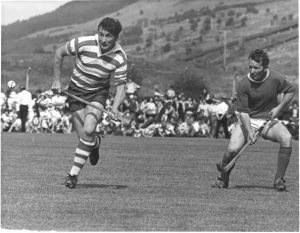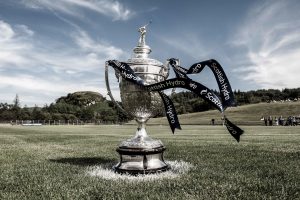
By Hugh Dan MacLennan and Grant Jarvie
One of Scotland’s oldest and most valuable cultural assets is to be showcased from October 2015, for six months, in the award winning Scottish Football Museum at Hampden Park, Glasgow.
Shinty – Irish missionaries probably introduced iomain or camanachd in Gaelic – to Scotland two thousand years ago, almost certainly along with the Gaelic language.
It is one of the few sports that can claim to be native to Scottish soil and has a significantly important cultural dimension through its Gaelic heritage.
It is also one of the cultural anchors that has offered the Scottish diaspora an historical link with their roots along with Gaelic and Highland Games.
The sport’s main trophy in the modern era is The Camanachd Cup – the national championship trophy, first played for in 1896.
Many of shinty’s great trophies will be on display on a planned rotation and clubs and Associations within the game are to be offered the opportunity to be part of the six-month exhibition.
KEY FACTS AT JULY 2015
Shinty has been played throughout Scotland, including St Kilda, but never in Orkney or Shetland.
- Shinty was traditionally played as a social pastime and particularly in association with New Year celebrations, prior to its organisation as a sport with rules and regulations in the latter part of the 19th
- Before the leather, stitched balls were introduced at the end of the 1800s, balls were made from wood, woven wool, sheep vertebrae and even dried seaweed stalks.
- Several football teams and stadia in England have a shinty connection such as Old Trafford and Stamford Bridge.
- Shinty has been played at Hampden Park in Glasgow and other stadia such as Parkhead and Ibrox on occasion.
- On Sunday 2nd March 2014 the newly formed club, Krasnodar Camanachd, held what is believed to have been the first shinty match on Russian soil.
- Shinty’s greatest ever goal-scorer was Kingussie’s Ronald Ross who amassed more than 1,000 goals in his playing career.
- A number of top footballers were noted shinty players in their day, notably Duncan Shearer, ex Aberdeen and Chelsea, and Donald Park of Inverness Caledonian, Hearts, Hibs and Partick Thistle.
- Shinty’s blue riband trophy and the Scottish championship is the SSE Scottish Hydro Camanachd Cup, first played for in 1896.
- A shinty stick is known by its Gaelic name, caman.
- When Scottish emigrants left to the four corners of the globe in the 19th century in particular, they took their culture with them and traces of shinty are to be found in Australia, New Zealand, Canada and even in Montevideo.
- During the two World Wars and the Boer War before that, Highland soldiers used shinty to help them maintain their links with home and keep their spirits up. Shinty is to be found at regimental camps, on the front line and in POW camps.
- There currently is one player in Scotland’s Sporting Hall of Fame, Dr Johnnie Cattanach of Newtonmore. An all-round sportsman who distinguished himself at Edinburgh University, he holds the record of most goals scored in a Camanachd Cup Final (8) and was killed at Gallipoli in World War 1.
Shinty Trophies

Source: Shinty Archive
The rich heritage of shinty, with its spectacular range of silverware, is a national cultural asset. Many of the sport’s most historic trophies are still used in competition, the oldest being the Glasgow Celtic Society Cup, dating from 1879. Others include Aberdeen University’s Littlejohn Vase (1905), a solid silver reproduction of the 400 BC Roman original that is in the Burrell Collection in Glasgow, accompanied by a lavishly illustrated album of dedication.
Shinty Milestones
- 1272 earliest written reference to shinty.
- 1589 Shinty banned from Blackfriars Kirkyard in Glasgow.
- 1698 Martin Martin refers to shinty play on St Kilda.
- 1820 Robert Chambers recorded shinnie playing in the borders.
- 1842 Shinty in Sydney, Australia.
- 1843 Argyll-shire Roads Act banned shinty play on streets.
- 1851 Aberdeen University shinty club, oldest shinty club with written constitution
- 1893 Camanachd Association, shinty’s governing body, formed.
- 1924 First Shinty/Hurling international – Scotland v Ireland at Tailteann Games, Dublin.
- 1953 Lovat Shinty Club first to win all six senior Scottish shinty trophies, a feat never repeated and now impossible.
- 2005 Shinty moved to include summer play.
Shinty/Hurling matches have been played at various levels between Scotland and Ireland since the 1880s and the international fixture remains a vibrant link between Celtic traditions.
Shinty is a sport that has been at the heart of communities stretching from the Western Isles and North West Ross-shire to Caithness and the Mull of Kintyre and beyond to London, Manchester, Cornwall and the Scottish diaspora world-wide.
At least three sports shinty, curling and golf are regarded widely as but three of national indigenous sports of Scotland. They have all, at one time or another been played throughout the country and are recognized worldwide as iconic symbols of the country’s sporting heritage.
Alzheimer Scotland and the Camanachd Association have set up a special project for people living with dementia and other memory problems. Called Shinty Memories, it uses images of old players, teams, badges, trophies, grounds and memorabilia to improve recall, stimulate conversation and share memories of Shinty.
WHY SPORTS HISTORY MATTERS
The history of sport matters for a number of reasons:
It helps to avoid a parochial or insular understanding of sport.
It provides tools by which to evaluate change.
It helps to destroy myths.
It warns against an uncritical acceptance of heritage, tradition and identity.
It can add plausibility to not just sporting issues of the day but also broader problems and issues.
It can bring voices and records from the past to bear on contemporary challenges.
Conclusion
You cannot understand Gaelic culture fully without recognizing the place of shinty in Gaelic speaking communities and you cannot understand Scotland or the Scottish diaspora fully without acknowledging Scotland’s cultural assets.
The partnership between The Camanachd Association and the Scottish Football Museum helps to evidence that the sports past has much to offer contemporary Scotland.
Shinty is a sport that values its tradition and heritage greatly and also its contemporary social and economic role in Scotland’s well being.
Read more about Sport on the Academy of Sport’s website.


